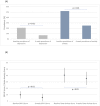Anxiety, depression and quality of life in acute high risk cardiac disease patients eligible for wearable cardioverter defibrillator: Results from the prospective multicenter CRED-registry
- PMID: 30856204
- PMCID: PMC6411111
- DOI: 10.1371/journal.pone.0213261
Anxiety, depression and quality of life in acute high risk cardiac disease patients eligible for wearable cardioverter defibrillator: Results from the prospective multicenter CRED-registry
Abstract
Background: Psychological distress is common in patients with cardiovascular disease and negatively impacts outcome.
Hypothesis: Psychological distress is high in acute high risk cardiac patients eligible for a WCD, and associated with low quality of life. Distress is aggravated by WCD.
Methods: Consecutive patients eligible for a WCD were included in the prospective, multicenter "Cologne Registry of External Defibrillator" registry. Quality of life (Short Form-12), depressive symptoms (Beck-Depression Inventory II) and anxiety (State Trait Anxiety Inventory) were assessed at enrollment and 6-weeks, and associations with WCD prescription were analyzed.
Results: 123 patients (mean [SD] age 59 [± 14] years, 75% male) were included, 85 (69%) of whom received a WCD. At enrollment 21% showed clinically significant depressive symptoms and 52% anxiety symptoms, respectively. At 6 weeks, depressive and anxious symptoms significantly decreased to 7% and 25%, respectively. Depressive symptoms at enrollment and changes at 6 weeks showed significant associations with health-related quality of life, whereas anxious symptoms did not. There was a trend for better improvement of depression scores in patients with WCD (mean [SD] change in score points: -4.1 [6.1] vs -1.8 [3.9]; p = 0.09), whereas change of the anxiousness score was not different (-4.6 [9.5]) vs -3.7 [9.1], p = 0.68).
Conclusion: In patients eligible for a WCD, depressive and anxiety symptoms were initially common and depressive symptoms showed a strong association with reduced health-related quality of life contributing to their clinical relevance. WCD recipients showed at least similar improvement of depression and anxiety at 6 weeks when compared to non recipients.
Conflict of interest statement
MW received financial support from ZOLL Medical Corporation in the form of a limited salary for the assessment of registry data. This does not alter our adherence to PLOS ONE policies on sharing data and materials.
Figures
References
-
- Piepoli MF, Hoes AW, Agewall S, Albus C, Brotons C, Catapano AL, et al. 2016 European Guidelines on cardiovascular disease prevention in clinical practice: The Sixth Joint Task Force of the European Society of Cardiology and Other Societies on Cardiovascular Disease Prevention in Clinical Practice (constituted by representatives of 10 societies and by invited experts)Developed with the special contribution of the European Association for Cardiovascular Prevention & Rehabilitation (EACPR). Eur Heart J. 2016;37(29):2315–81. 10.1093/eurheartj/ehw106 . - DOI - PMC - PubMed




